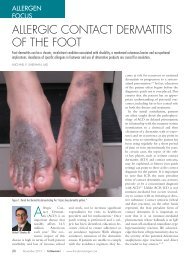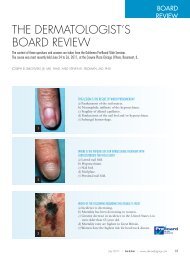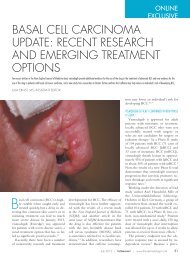Download PDF - The Dermatologist
Download PDF - The Dermatologist
Download PDF - The Dermatologist
Create successful ePaper yourself
Turn your PDF publications into a flip-book with our unique Google optimized e-Paper software.
Volume 5, Number 1 Winter 2005<br />
Brought to you courtesy of<br />
Stiefel Laboratories, Inc.<br />
THE MAKERS OF DUAC ® , ROSAC ® , AND BREVOXYL ®<br />
Pathways<br />
Editor’s Message<br />
James Q. Del Rosso, DO, FAOCD<br />
Dear Readers:<br />
This edition of PATHWAYS begins<br />
with an article on selling skin care<br />
products in the office setting. Selling<br />
these products, also known as cosmeceuticals,<br />
can be beneficial to both<br />
dermatologist and patient if conducted<br />
in the proper way. Dispensing<br />
appropriately and ethically, whether<br />
you choose to sell your own product<br />
line or a commercially available one, is<br />
key. Here, several dermatologists<br />
share their experiences with dispensing<br />
cosmeceuticals in their offices.<br />
Next, we present an article on<br />
getting published. While publishing<br />
one’s work can launch a new dermatologist<br />
into the ongoing clinical<br />
discussion of dermatologic practice,<br />
this process can be challenging for<br />
the new physician-author. This article<br />
explores the different avenues of<br />
publishing—poster presentation,<br />
journal article, or book—and<br />
describes what one can expect<br />
along the way. <strong>The</strong> author discusses<br />
the importance of deciding on a<br />
topic, determining the audience,<br />
and selecting an appropriate<br />
avenue. As the author suggests,<br />
most dermatologists who publish<br />
find the experience rewarding. It is<br />
our hope that this process of sharing<br />
the latest in dermatologic treatment<br />
will improve care of the patient.<br />
Please e-mail any comments or<br />
suggestions for PATHWAYS to me<br />
through stuleya@hmpcommunications.com.<br />
As always, I hope you find<br />
PATHWAYS valuable and enjoyable.<br />
Sincerely,<br />
James Q. Del Rosso,<br />
DO, FAOCD<br />
Editor, PATHWAYS<br />
Private Dermatology<br />
Practice, Las Vegas Skin<br />
& Cancer Clinics and<br />
Clinical Assistant Professor, Department of<br />
Dermatology, University of Nevada School of<br />
Medicine, Las Vegas, Nevada<br />
Practical career advice for dermatology residents<br />
Selling Cosmeceuticals<br />
in Your Practice<br />
Several dermatologists share their<br />
thoughts on dispensing skin care products.<br />
By Adam Marcus<br />
Walk into many dermatologists’ offices these days,<br />
and alongside the stacks of medical pamphlets,<br />
popular magazines, and other standard accouterments<br />
is new scenery: stacks and rows of precious—and<br />
preciously packaged—balms, ointments, and salves<br />
promising more youth and vitality than the mere skin cream<br />
could ever dare to dream.<br />
WHAT ARE COSMECEUTICALS?<br />
<strong>The</strong>se so-called “cosmeceuticals,” cosmetics that boast medicinal powers,<br />
are becoming an increasingly common fixture in dermatology.<br />
<strong>The</strong> US Food and Drug Administration (FDA) does not consider the term<br />
“cosmeceutical” a legal definition. Products marketed as cosmeceuticals are treated<br />
as cosmetics, meaning they do not have to gain FDA approval prior to being sold.<br />
Cosmeceuticals are a booming business. Revenues for the industry were<br />
expected to reach $6.4 billion in 2004, up 7.3 percent from the prior year,<br />
according to a recent article in BusinessWeek’s online edition. 1 Several cosmetic<br />
“giants,” from Estee Lauder to Revlon, make cosmeceutical lines, as do a<br />
Photo courtesy of Evelyn Jones, MD, Paducah, KY.<br />
continued on page 2<br />
© 2005 HMP Communications<br />
83 General Warren Blvd., Ste. 100<br />
Malvern, PA 19355<br />
800-237-7285 or 610-560-0500<br />
HMP Communications<br />
Also Inside:<br />
• <strong>The</strong> Inside Track to Getting Published
Pathways: Winter 2005<br />
continued from page 1<br />
handful of pharmaceutical companies,<br />
including Johnson & Johnson.<br />
COSMECEUTICALS IN<br />
THE OFFICE SETTING<br />
Dr. Mary Lupo, a New Orleans<br />
dermatologist who has her own line of<br />
skin care products, said she first considered<br />
embarking on the project in<br />
1989.“I liked [alphahydroxy acids] and<br />
couldn’t get information from companies<br />
on acid concentrations, etc.,” said<br />
Lupo, a clinical assistant professor of<br />
dermatology at Tulane University<br />
Medical School. “It took me until<br />
1994 to find a biochemist I thought I<br />
could work with.” Her product line<br />
came out the next year and now<br />
includes 10 items.<br />
Lupo displays her skin care products<br />
in a pedestal case that takes up<br />
“no more [space] than a chair.” She<br />
also has another case where patients<br />
check out of the office, from which<br />
staff can retrieve products. “<strong>The</strong> case<br />
has storage underneath, and we have<br />
more products down in our laser<br />
area,” she said.<br />
Lupo estimates that dispensing<br />
products takes “a few hours” a month to<br />
educate patients, monitor inventory,<br />
and otherwise handle the items. In<br />
addition to her own line, Lupo dispenses<br />
two others, Procyte and Kinerase,<br />
and will soon carry a third, Prevage.<br />
How does she choose which<br />
products to offer? “<strong>The</strong> most important<br />
element in deciding is to believe<br />
in the products you sell and understand<br />
how to recommend them to<br />
patients. It should not be about<br />
money but rather good patient care. If<br />
they are doing well and like their<br />
existing products, I don’t push mine<br />
just to make a sale.”<br />
Dr. Patricia Farris, a clinical assistant<br />
professor of dermatology at<br />
Tulane University Medical Center, in<br />
New Orleans, said she uses herself as<br />
her own guinea pig.“I never buy anything<br />
that I don’t try myself. Personally,<br />
I can’t sell anything I don’t love.<br />
My motto is ‘great products at a great<br />
price point.’”<br />
Farris said most of the fun dispensing<br />
products comes when she<br />
talks with patients about what works<br />
and what doesn’t, “and saving them<br />
money on expensive brands that are<br />
not worth the money” is also pretty<br />
enjoyable. “Patients really appreciate<br />
this and find it a value-added service.”<br />
As for the business end, how<br />
much doctors make depends on how<br />
committed they are to dispensing, she<br />
said. Many dermatologists sell products<br />
in the office. Fewer take the time<br />
to talk with patients about what they<br />
should be using. More often, those<br />
recommendations come from office<br />
staff instead of the physicians themselves,<br />
a practice that should be<br />
reversed, she said.<br />
What happens if a product doctors<br />
sell is no longer produced or for some<br />
reason loses luster—leaving patients on<br />
a limb? That’s a risk, admits Farris.“We<br />
have had problems with products that<br />
are discontinued, but I try to find<br />
something to replace it with that is<br />
comparable.”<br />
While a growing<br />
number of<br />
dermatologists<br />
dispense<br />
cosmeceuticals,<br />
they’re now<br />
competing, often<br />
unsuccessfully,<br />
with the Internet.<br />
Dr. Mark Nestor, director of the<br />
Center for Cosmetic Enhancement, in<br />
Aventura, FL, sells his own line of cosmetic<br />
products, as well as selects others<br />
that he likes.<br />
“If you dispense appropriately and<br />
ethically, we’re essentially giving benefit<br />
to patients that they don’t have otherwise,”<br />
said Nestor, who is also an<br />
associate professor of dermatology and<br />
cutaneous surgery at the University of<br />
Miami School of Medicine.“You can’t<br />
get these cosmeceuticals most are dispensing<br />
elsewhere.”<br />
Nestor’s practice has offered<br />
patients several product lines in recent<br />
years. He also has developed a touchscreen<br />
computer system, called Dermassist,<br />
that guides patients to the<br />
products right for their particular skin<br />
types. Patients who want to buy<br />
something are given a one-month<br />
supply of the item, which they must<br />
pay for out of pocket, since health<br />
insurance doesn’t cover the items. If<br />
the product doesn’t help, Nestor<br />
added, he will work with the patient<br />
to find something better.<br />
While a growing number of dermatologists<br />
dispense cosmeceuticals—<br />
surveys show about 40 percent, Nestor<br />
said—they’re now competing, often<br />
unsuccessfully, with the Internet.<br />
“Some companies and doctors are<br />
looking at this as a quick revenue<br />
source, and that undercuts doctors<br />
who sell them in the office” where<br />
overhead is higher than in cyberspace.<br />
“Patients are coming in saying,<br />
‘You charge me more than what I can<br />
get on the Internet.’”That’s friction no<br />
one wants, he said. As a result, doctors<br />
are increasingly turning to proprietary<br />
product lines that offer brand distinction.<br />
“<strong>The</strong>y make sure it’s a private<br />
label,” he said.<br />
Dr. Kenneth Beer, founder of<br />
Palm Beach Esthetic Center, in West<br />
Palm Beach, FL, has been selling his<br />
own label of skin care products for a<br />
decade. But the label has changed several<br />
times over the years, as Beer struggled<br />
to find a producer with which he<br />
felt comfortable. Usually, the rifts that<br />
forced breakups involved poor packaging<br />
or, more often, weak product and<br />
sales support.“If a company sells you a<br />
product and that’s the last time you<br />
hear from them, and they never come<br />
in to see how things are going, you sit<br />
with inventory, your staff doesn’t want<br />
to sell it, and patients don’t want to<br />
buy it,” he said.<br />
Beer has been buying his current<br />
product line, Palm Beach Esthetic,<br />
from the same New York-based supplier<br />
for the last five years, a relationship<br />
he considers successful. However,<br />
he is about to make a significant shift<br />
away from office-based dispensing by<br />
opening a day spa dedicated to skin<br />
care procedures. <strong>The</strong> move will free<br />
up his office staff members, who<br />
already are swamped with cosmetic<br />
patients and “don’t have the time or<br />
the desire to deal with products,” he<br />
PAGE 2
Dispensing Cosmeceuticals<br />
Photo courtesy of Evelyn Jones, MD, Paducah, KY.<br />
Opening a day spa<br />
that focuses<br />
exclusively on skin<br />
care could spur<br />
sales of creams<br />
and lotions that<br />
languish on the<br />
shelves of a<br />
dermatology suite.<br />
said. It will also vacate much needed<br />
real estate in his office, which can’t<br />
handle any more display cases.<br />
Financial considerations also play<br />
a role in the decision, Beer said. He<br />
typically turns over product inventory<br />
every 30 to 45 days. “It’s less than<br />
I’d hoped for, and we’d like to turn it<br />
faster,” he said. Opening a day spa<br />
that focuses exclusively on skin care<br />
could spur sales of creams and lotions<br />
that languish on the shelves of a dermatology<br />
suite.<br />
Like many of his colleagues, Beer<br />
was attracted to dermatology because<br />
of the entrepreneurial prospects it<br />
promised. “You have the opportunity<br />
to do a few very interesting business<br />
things,” he said, including creating<br />
individualized product lines—something<br />
he said he wanted to do from the<br />
start of his medical career. New dermatologists,<br />
he advises, should start<br />
thinking about that side of their practices<br />
immediately. “I would start it<br />
early. It’s a lot easier to set the stage<br />
early and build your own brand as<br />
you’re building your practice then to<br />
have your brand built and say, ‘Hey, I<br />
want to modify it.’” ■<br />
REFERENCE<br />
1. Tsao A.<strong>The</strong> changing face of skin care. BusinessWeek<br />
online. November 30, 2004. Available<br />
at: http://www.businessweek.com/<br />
bwdaily/dnflash/nov2004/nf20041130_096<br />
2_db035.htm. Accessed December 29, 2004.<br />
Adam Marcus is a contributing editor<br />
for Skin & Aging magazine. Send correspondence<br />
to Adam by e-mail at amarcus3@nyc.rr.com.<br />
PAGE 3
Pathways: Winter 2005<br />
<strong>The</strong> Inside Track<br />
to Getting Published<br />
Publishing is a great way to immerse oneself in the ongoing clinical discussion of<br />
dermatologic practice, but many new authors may not know how to tackle this endeavor.<br />
By Jo Ann Le Quang<br />
Publishing your work is more than just getting your<br />
name in print or having one more thing to add to your<br />
curriculum vitae.As most authors have come to realize,<br />
getting published means participating in the ongoing<br />
clinical discussion of dermatologic practice. Never before in history<br />
has the conversation among the learned men and women<br />
of dermatology been so exciting. Breakthrough drugs, new treatment<br />
options, and more complete understanding of disease<br />
processes continue to emerge.<br />
WHERE TO BEGIN<br />
“Getting started as an author can<br />
be daunting,” said Stacey Moore, owner<br />
of Physician Resources, an organization<br />
focused on consulting in dermatologic<br />
medical education and dedicated to<br />
helping dermatologists publish their<br />
work. “But there are many ways that<br />
physician-authors can improve their<br />
chances of getting published.”<br />
<strong>The</strong> first strategy behind getting<br />
published involves having a plan.<br />
“Physicians need a strategy first,”<br />
Moore explained. “Selecting a topic<br />
can be challenging. <strong>The</strong>y need to<br />
define their area of interest and/or<br />
expertise within their field.”<br />
Moore recommends that new<br />
authors start from their comfort zone.<br />
“<strong>The</strong> writing process becomes easier<br />
once you are comfortable with your<br />
subject matter. Some ways to select a<br />
topic include identifying problems<br />
solved or interventions implemented<br />
for particular diagnoses, including new<br />
information or treatment approaches,<br />
patient interactions, and research studies<br />
or quality improvement projects.<br />
Once you gather resources for<br />
researching your topic, this should also<br />
help to determine which journal to<br />
target for publication of your article.<br />
Some journals want a clinical perspec-<br />
PAGE 4
Getting Published<br />
tive, and others focus on researchbased<br />
articles.<br />
“While journals are one choice,<br />
the opportunity to present at a national<br />
society meeting or publish a scientific<br />
poster presentation is an ideal option<br />
for some potential authors. <strong>The</strong> first<br />
step is to decide what you have to<br />
communicate and to what audience<br />
and explore the options,” she adds.<br />
Some publishers and organizations<br />
field inquiries about possible future topics<br />
and often publish on their websites<br />
or in their journals a “call for abstracts.”<br />
It is not out of place for a prospective<br />
author to contact a journal, publisher, or<br />
organization and express interest in<br />
developing material on specific content.<br />
If the publisher thinks the material<br />
might be suitable, the author is advised<br />
to develop the idea more formally.<br />
“Preparation, submission, and presentation<br />
of an abstract are important<br />
steps in the research process that can<br />
benefit the investigator/author. <strong>The</strong><br />
abstract typically describes a study and<br />
its results, but the first step in writing<br />
an abstract includes reading the<br />
instructions or guidelines given from<br />
the journal, society, or organization.<br />
First-time authors might find it helpful<br />
to read through published abstracts<br />
from the most recent annual meeting<br />
to help illustrate the concepts discussed<br />
in that article, poster, or presentation<br />
and develop a feel for what a good and<br />
accepted abstract looks like,” says<br />
Moore.<br />
Even scholarly publishers and<br />
meeting planners have to “market”<br />
their materials, so they are looking for<br />
content that is timely, of great interest<br />
to the target audience, and—ideally—<br />
not presented as well or as thoroughly<br />
in other places. Identifying the channels<br />
and their respective target audiences<br />
is an easy but often overlooked<br />
step by new authors.<br />
Most publications have authors’<br />
guidelines, which specify how they wish<br />
to receive materials. Conventions and<br />
society meetings may have regulations—and<br />
deadlines—as to what sort<br />
of materials to submit. Adherence to<br />
these guidelines and their deadlines<br />
greatly enhances the chance that the<br />
material will be published. Publishers—<br />
no matter how interested in a specific<br />
topic—may not be able to work with<br />
material that is submitted past deadline<br />
or not in the proper format.<br />
One general rule in publishing: it<br />
never hurts to ask. Provided queries are<br />
brief and on-point, most publishers<br />
prefer getting them to full-blown<br />
materials that may not be exactly what<br />
they seek. But once an author and a<br />
publisher have established that they<br />
want to work together, a very different<br />
phase of the project commences.<br />
It is not out of<br />
place for a<br />
prospective author<br />
to contact a<br />
journal, publisher,<br />
or organization<br />
and express<br />
interest in<br />
developing<br />
material on<br />
specific content.<br />
PREPARING YOUR MATERIALS<br />
Developing the material can be the<br />
most exciting—or the most bothersome—part<br />
of the project.<br />
“I don’t recommend spending<br />
serious time developing the final manuscript<br />
until it has found a potential<br />
‘home,’” added Moore. “It is wise to<br />
work with the editor to define the<br />
material and be sure there is interest<br />
and a need for the content. Even before<br />
the first word of an article is written, a<br />
good editor is already helping to shape<br />
the final product.”<br />
In terms of writing, most writer’s<br />
guidelines help define the format and<br />
scope of the article. For physicians<br />
comfortable with organizing their<br />
thoughts on paper, writing can go<br />
quickly. Others may rely on assistants,<br />
support staff, or even freelance writers<br />
to produce the material.<br />
“When you write a manuscript or<br />
even construct a presentation, there are<br />
really three phases involved,” Moore<br />
explained. “<strong>The</strong> first is writing, the act<br />
of getting the thoughts down on paper<br />
or typed in the computer. <strong>The</strong> second<br />
phase is gathering resources or<br />
researching your topic, including<br />
obtaining references. Unless your manuscript<br />
is historical in nature, references<br />
that are over 10 years old should be<br />
scrutinized to account for new information<br />
that may have been published.<br />
<strong>The</strong> third phase is editing, which<br />
means going through that material<br />
meticulously to make sure it has good<br />
structure, inherent logic, and clarity.<br />
Rarely is anybody good at both writing<br />
and editing, so don’t be afraid to go<br />
to a peer or professional for his or her<br />
opinion prior to submission.Try not to<br />
be afraid of criticism or suggestions<br />
that might enhance your manuscript.<br />
Most of us—even professionals in publishing—tend<br />
to be either more in the<br />
writing camp or more in the editing<br />
camp. Find out which strength is yours<br />
and get help with the other part.”<br />
For some physician-authors, this<br />
may mean submitting data, notes, and<br />
ideas to a ghostwriter to get the first<br />
draft put together. For other physicianauthors,<br />
it may mean contracting with<br />
a freelance editor to review the article<br />
and suggest ways to improve it. Most<br />
journals offer editorial support as well,<br />
but the more finalized material is when<br />
it arrives at the journal, the better the<br />
chance it will get printed. “It can be<br />
very competitive out there,” Moore<br />
remarked. “Journals are extending the<br />
amount of review time for manuscripts,<br />
and editors are more inclined to<br />
favor finalized material over manuscripts<br />
that they have to help organize<br />
or create. Use spell-check, follow the<br />
instructions or guidelines for authors,<br />
and organize your thoughts within the<br />
manuscript.”<br />
Illustrations can be a crucial component<br />
in creating a powerful publication,<br />
but few dermatologists have the<br />
skills necessary to produce professional-level<br />
art work.<br />
“Most publishers know this and<br />
have access to artists who can develop<br />
charts, graphs, diagrams, and drawings.<br />
<strong>The</strong>re are also agencies or freelance<br />
designers or artists who can help doctors<br />
develop animations for presentations,”<br />
Moore stated.“When a publish-<br />
PAGE 5
Pathways: Winter 2005<br />
er develops the art work, you should<br />
clarify who owns it, in case you want<br />
to use it later. I advise all of the doctors<br />
I work with to copyright their<br />
original work.”<br />
For dermatologists, photography<br />
can also be a necessary component of a<br />
publication.<br />
“Digital photography is really<br />
changing dermatology publishing,”<br />
Moore commented. “More physicians<br />
are realizing that they can take goodquality<br />
patient photos right in the<br />
office.” Moore advises physicians who<br />
might be photographing their own<br />
patients to develop a standard modelrelease<br />
form to keep on file. <strong>The</strong><br />
advent of digital photography now<br />
means dermatologists can include<br />
electronic files of actual case studies<br />
for consideration with the material<br />
they submit.<br />
“<strong>The</strong> presence of good photographs<br />
or other illustrations makes<br />
whatever material you submit more<br />
powerful,” Moore commented. “It’s<br />
<strong>The</strong> advent of<br />
digital<br />
photography now<br />
means<br />
dermatologists<br />
can include<br />
electronic files of<br />
actual case<br />
studies for<br />
consideration<br />
with the material<br />
they submit.<br />
always better to provide whatever<br />
images you can—particularly in dermatology.”<br />
While book authors are entitled to<br />
royalties on their work (typically about<br />
10% of the retail price of the book but<br />
subject to negotiation with the publisher),<br />
article authors may not always<br />
be remunerated. Fees for speaking<br />
engagements vary widely. Physicians<br />
who present posters at certain meetings<br />
may discover that not only is there<br />
no honorarium, there may be out-ofpocket<br />
expenses involved in creating<br />
the poster itself.<br />
“Everybody should be paid for<br />
their work,” Moore said, but she admits<br />
that the world of academic medical<br />
publishing can sometimes seem challenging.“Sometimes<br />
it involves finding<br />
sponsors or grantors for the project.<br />
Specialty societies and other organizations<br />
are one option. Corporate support<br />
also comes into play but in the<br />
form of grants that do not restrict the<br />
authors in terms of the content.” She<br />
noted that a majority of scientific<br />
poster presentations have grantors who<br />
may provide an honorarium to the<br />
PAGE 6
Getting Published<br />
author and may pick up the expenses<br />
of producing the poster and of registering<br />
for the meeting itself.<br />
As the written material makes its<br />
transition to final format—article,<br />
book, poster, live presentation—<br />
authors are cautioned to be meticulous<br />
about references. Bibliographic references<br />
are an important component of<br />
many publications.<br />
“References have to be precise.<br />
Use the format specified by the publisher<br />
or let your editorial assistant help<br />
you. Most authors tend to under-reference<br />
rather than over-reference, so<br />
when in doubt, add the citation. You<br />
never know what physician will need<br />
and use that reference later on.” Moore<br />
encourages all dermatologists with an<br />
interest in publication to find a computer<br />
software program that will automatically<br />
format references or convert<br />
citations from one format to another.<br />
Part of the burden of creating adequate<br />
references is the gracious art of<br />
giving credit where credit is due. A<br />
solid bibliography is less an act of<br />
scholarly discipline than an acknowledgement<br />
of others whose work has<br />
influenced the author.<br />
WHAT TO EXPECT<br />
Much material that gets published<br />
in the world of scholarly dermatology<br />
involves a stringent review process,<br />
usually by other experts in the field.<br />
<strong>The</strong>y are free to analyze and critique<br />
anything from the data to the illustrations<br />
to the wording of a particular<br />
sentence.<br />
“You can’t be thin-skinned as an<br />
author,” Moore advised. “Fortunately,<br />
the peer-review process is a great<br />
safety net for us, and most authors<br />
come to respect the process.<strong>The</strong> most<br />
onerous part of review is the time it<br />
takes. Depending on the publication,<br />
it can take weeks or even months for<br />
a finished article to get through<br />
review. That can be hard on the<br />
author and others who want to see<br />
the material in print.”<br />
Even after an article is accepted<br />
for publication, it can take many<br />
more months before it actually<br />
appears.“That’s why I like poster presentations<br />
so much,” Moore commented.<br />
“It’s a fast-track to get the<br />
ideas published and into discussion.”<br />
Presentations and even continuing<br />
medical education (CME) activities<br />
can also net faster results than the traditional<br />
journal article.<br />
Another trajectory for a physicianauthor<br />
is to initially develop a live presentation<br />
that later becomes a poster or<br />
an article. Most dermatologists who<br />
enter the world of publishing find it<br />
engaging, rewarding, and invigorating,<br />
once they learn the ropes.<br />
“Physician Resources strives to<br />
continue to raise awareness of the<br />
important role of the dermatologist,”<br />
Stacey Moore said about her business,<br />
which opened two years ago and works<br />
only with dermatologists.“We want to<br />
help facilitate the process of communicating<br />
the latest ideas in dermatologic<br />
treatment and prevention. It is my hope<br />
that this will ultimately impact the dermatologic<br />
patient in a positive way to<br />
enhance his or her care.” ■<br />
Jo Ann LeQuang is a freelance medical<br />
writer based in Angleton, Texas. Contact<br />
Jo Ann at LeQ Medical, 1216 N.Velasco<br />
Street, Suite J, Angleton, TX 77515;<br />
telephone 979-864-4479; fax 979-864-<br />
3930; e-mail joann@leqmedical.com.
HMP COMMUNICATIONS<br />
83 General Warren Blvd., Suite 100<br />
Malvern, PA 19355<br />
800-237-7285<br />
PRSRT STD<br />
US POSTAGE<br />
PAID<br />
BENSALEM, PA<br />
PERMIT #182
















